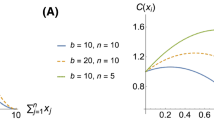Abstract.
In 1978, Oster and Wilson proposed a bang-bang investment strategy for social insects in which colony size at maturity amplifies colony reproduction. In this paper, the investment strategies of the monogyne form of the fire ant, Solenopsis invicta, were compared to the predictions of the bang-bang model. Demographic census data, collected on fire ant mounds excavated every month during the years 1985 and 1988, revealed that colony reproduction was independent of colony size (~50,000 to ~250,000 workers). Why were mature S. invicta colonies up to five times larger than they needed to be to reproduce an annual batch of sexual offspring? To address this question, Oster and Wilson's bang-bang model was modified to a "yoyo-bang" investment strategy for perennial societies. In the yoyo-bang model, excess workers are a disposable reserve – a buffer – that can oscillate up or down depending on resource availability without adversely affecting annual reproductive cycles. The yoyo-bang model links colony size, colony survival and lifetime reproductive fitness.
Similar content being viewed by others
Author information
Authors and Affiliations
Corresponding author
Additional information
Electronic Publication
Rights and permissions
About this article
Cite this article
Cassill, D. Yoyo-bang: a risk-aversion investment strategy by a perennial insect society. Oecologia 132, 150–158 (2002). https://doi.org/10.1007/s00442-002-0928-2
Received:
Accepted:
Published:
Issue Date:
DOI: https://doi.org/10.1007/s00442-002-0928-2




